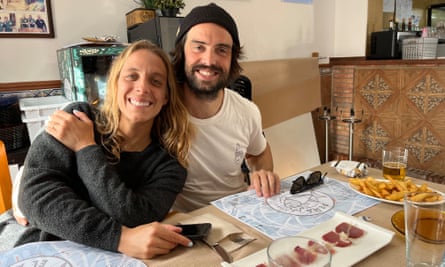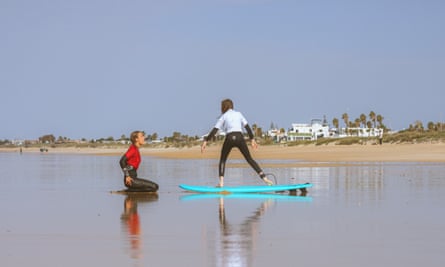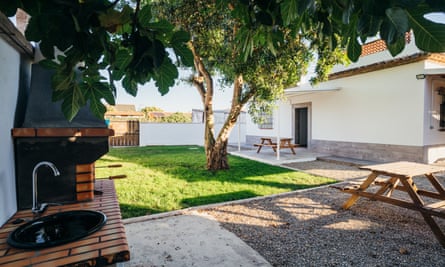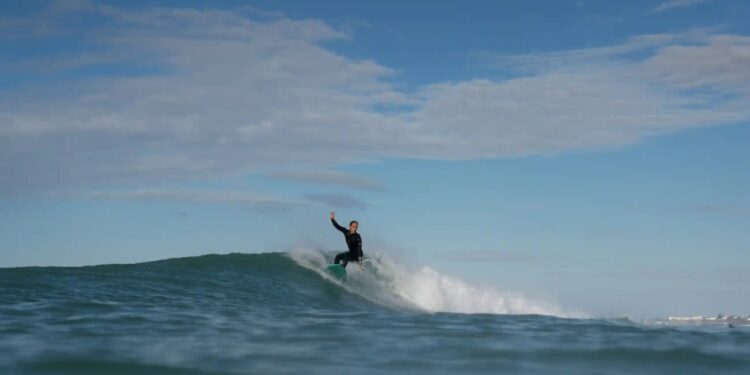A new surf camp in Andalucía offers sunshine and a high chance of perfect waves, combined with low prices and a friendly vibe
The sun is blindingly bright, the air balmy, the sea a clear turquoise-blue and 18C, with no suspicious murky stripes of pollution. Paddling out into the Atlantic from El Palmar, on south-west Spain’s Costa de la Luz, is a far cry from a January surf experience in the UK.https://interactive.guim.co.uk/maps/embed/jan/2023-01-18T16:10:53.html
I’ve come to Andalucía to escape the bleakness of the British winter with a stay at The Sea Retreat, a new surf camp on the coast between Cádiz and Tarifa. Set up by Marina Nieves and her husband Callum Jelley in the laid-back community of El Palmar – the name means “palm grove”, it caters for beginners and intermediates, with a maximum of eight adults staying in the surf house at any one time (some rooms can accommodate extra children too).
Callum, the only British voice I’ll hear all week, is from Yorkshire and Marina is from Seville, though has been coming to El Palmar with her family since she was little, as evidenced by how well she surfs, with enviable style and grace whatever the wave conditions.
El Palmar has a long, wild stretch of beach and gets 300-plus days of sunshine a year. It’s a mix of low-rise homes, cafes and bars with painted driftwood signage, surf schools and small farms. There are no house numbers or running water; instead residents use wells and bring in drinking water, but this being 2023 and the era of teletrabajo (remote working), there is of course wifi.
The Sea Retreat is based in a house just three minutes’ walk from the beach, with a mix of twin and double rooms. I wake to the sound of roosters crowing and at night the sky is flush with stars. There’s a garden and barbecue, and a chef prepares healthy food, from tofu noodles to Spanish tortilla each evening.

In the height of summer, the waves here are not good for surfing, and El Palmar gets so rammed with holidaymakers that many locals leave town and rent out their homes. According to Callum, January and February are the best months here – the weather usually mild as opposed to scorching, the vegetation its most lush and verdant, and the waves plentiful. Data from surf forecasting app Magic Seaweed suggests El Palmar has rideable waves 80% of the time in January (at my home break on the south coast of England, the figure is 29%). And while I am still wearing a wetsuit, it’s not a thick one, which makes paddling a lot easier.
While some cafes and restaurants are closed during my stay, there is plenty of life, from thirtysomethings carving past on surfskate boards and teens doing wheelies on motocross bikes to older couples on touring bikes and Germans of all ages in campervans, living their best #vanlife.

The outdoor wooden deck of Homies, my favourite coffee spot of the week, is always full of people smiling into the sunshine as if, like me, they can’t quite believe they’re cheating winter, and enjoying food and drink at much more affordable prices than back home.
The camp package includes one surf lesson a day of around two hours with Marina, and a guided sunset surf, which is a real highlight. Surf equipment can be borrowed anytime, so I do this a few times, getting out of the water when I could no longer move my arms rather than because I was cold.
We mostly surf at El Palmar: it’s a beach break with long whitewater rides for beginners and good conditions for progression for those wanting to improve in green, unbroken waves. On my trip there’s just one other couple – from Sardinia – but guests are generally a mix of Spanish and English, with a range of abilities, and Marina is a calm and patient coach for all levels. On the technical side, she helps the beginners with their pop-ups, and all of us with our wave selection and timing. I learn to position myself to catch the most powerful part of the wave, but she’s also really useful on the mental side. Surfing is a humbling sport, and when I’m feeling out of my comfort zone, the internal chatter can be overwhelming.
On a couple of mornings, the waves are too fast and powerful at El Palmar, so we head to a more sheltered spot nearby that is popular with longboarders. (Marina and Callum ask me not to mention its location, so it doesn’t get overrun. This isn’t a problem at El Palmar which has miles of space and plenty of peaks to surf on.)
For these days, I borrow a mid-length board made by a local shaper, and it rides like a dream. I sit in the lineup – the point where the waves begin to break – with a backdrop of sweeping dunes and hills covered in umbrella-shaped pines, the outline of Africa just visible in the distance. I don’t want these sessions to ever end.
One day we go for lunch at Peña El Atún, a relaxed seafood restaurant in nearby Barbate which specialises in tuna caught using the traditional Andalucían method of almadraba – using net traps. The freshest tuna I’ve ever eaten is offered as part of a menu including sashimi, tacos, tomato stews, and salmorejo, a thicker and creamier version of gazpacho. The bill comes to less than €20 a head.

On the way back in the van, we pass another secret longboard spot, the beginnings of new bike path which will one day link this section of coastline to Athens, and some graffiti protesting at hotels’ overuse of water in a region where the resource is under increasing pressure.
Another day, we hire bikes and ride to the north-west end of El Palmar beach, passing tufts of cane and pounding Atlantic waves, a picturesque stone observation tower and land slated for a controversial new hotel and beach club.
Compared with much of coastal Spain, this part of the Costa de la Luz is noticeably undeveloped, though this may not last. Marina and Callum believe there is a way to welcome visitors responsibly without harming El Palmar’s distinctive character and precious natural environment. Besides only hosting up to eight adult guests at a time, they encourage visitors to travel by train, and during the sunsets when we’re not surfing, we do beach cleans, strolling along the shore in the evening light picking up any litter we find.
Steering guests towards off-season travel is another way to reduce the impact of tourism – and this is a lot easier in places where the weather is mild. And where the waves are this good.
Source: The Guardian


Recent Comments